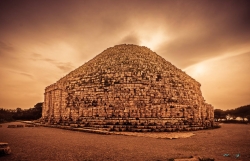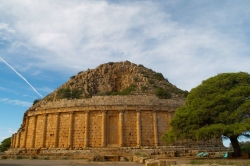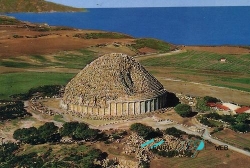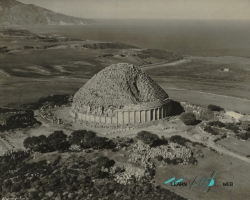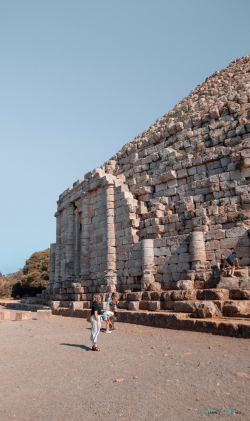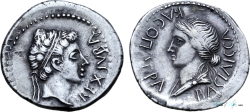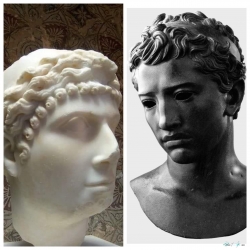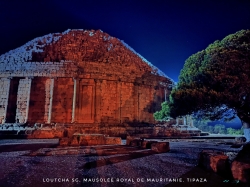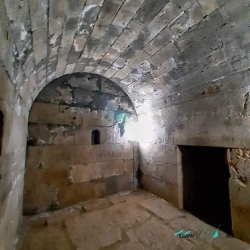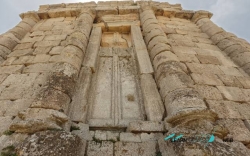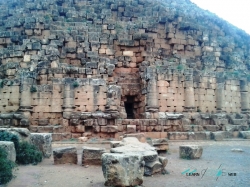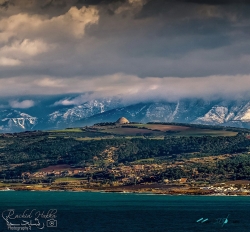The Royal Mausoleum of Mauretania is a funerary monument located on the road between Cherchell and Algiers, in Tipaza Province, Algeria. The mausoleum is the tomb where the Berber King Juba II and The Queen Cleopatra Selene II, sovereigns of Numidia and Mauretania, were allegedly buried. However, their human remains have not been found at the site, perhaps due to tomb raiding.
The sepulchre is sometimes known as the Mausoleum of Juba and Cleopatra Selene. In French, it is called the Tombeau de la Chrétienne ("the tomb of the Christian woman") because there is a Christian cross-like shape of the division lines on the false door.[citation needed] In Arabic, the mausoleum is called the Kubr-er-Rumia or Kbor er Roumia, which means "tomb of the Christian woman", as Rûm was taken in Arabic as the Eastern Roman Empire and, in North Africa, rumi took the meaning "Christian". It may have been a deformation of a Punic phrase for "the royal tomb".
The mausoleum was built in 3 BC by the last King of Numidia, and later King of Mauretania Caesariensis, Juba II (son of Juba I of Numidia) and his wife Cleopatra Selene II, She was an Egyptian-Greek Ptolemaic princess, the daughter of the Queen Cleopatra VII of Egypt and Roman Triumvir Mark Antony. Through her marriage to Juba II, she became the last Queen of Numidia and later Queen of Mauretania Caesariensis.
The mausoleum is probably the Royal Tomb that the 1st-century Roman geographer Pomponius Mela (1.31) described as the monumentum commune regiae gentis ("the communal mausoleum of the royal family"). If the geographer’s description of the mausoleum is correct, then the building was not intended just for Juba and Cleopatra, but envisaged as a dynastic funeral monument for their royal descendants.
The Mauretanian sepulchre looks similar to the Mausoleum of Augustus erected by the first Roman Emperor Augustus in Ancient Rome. Augustus began constructing his mausoleum between 29 BC-27 BC, some time before Juba II left Rome to return to Numidia.
The Royal Mausoleum of Mauretania is a common type of ancient mausoleums found in Numidia. It is built on a hill some 250 metres (756 feet) above sea level. The monument is entirely built from stone, while its main structure is in a circular form with a square base topped by a cone or a pyramid. The square base measures 60 to 60.9 metres square or 200 to 209 foot. The height of the monument was originally about 40 metres or 130’ in height. Due to damage that the mausoleum has suffered from natural elements and vandalism, the monument now measures 30-32.4 metres in height. The base of the monument was decorated with 60 Ionic columns whose capitals were removed, possibly stolen. Inside, the centre of the mausoleum has two vaulted chambers, separated by a short passage connected by a gallery outside by stone doors which can be moved up and down by levers. The passage leading to the chambers is about 500’. One chamber measures 142 feet long by 11 feet broad and is 11 feet high, while the other is smaller.
The sepulchre is sometimes known as the Mausoleum of Juba and Cleopatra Selene. In French, it is called the Tombeau de la Chrétienne ("the tomb of the Christian woman") because there is a Christian cross-like shape of the division lines on the false door.[citation needed] In Arabic, the mausoleum is called the Kubr-er-Rumia or Kbor er Roumia, which means "tomb of the Christian woman", as Rûm was taken in Arabic as the Eastern Roman Empire and, in North Africa, rumi took the meaning "Christian". It may have been a deformation of a Punic phrase for "the royal tomb".
The mausoleum was built in 3 BC by the last King of Numidia, and later King of Mauretania Caesariensis, Juba II (son of Juba I of Numidia) and his wife Cleopatra Selene II, She was an Egyptian-Greek Ptolemaic princess, the daughter of the Queen Cleopatra VII of Egypt and Roman Triumvir Mark Antony. Through her marriage to Juba II, she became the last Queen of Numidia and later Queen of Mauretania Caesariensis.
The mausoleum is probably the Royal Tomb that the 1st-century Roman geographer Pomponius Mela (1.31) described as the monumentum commune regiae gentis ("the communal mausoleum of the royal family"). If the geographer’s description of the mausoleum is correct, then the building was not intended just for Juba and Cleopatra, but envisaged as a dynastic funeral monument for their royal descendants.
The Mauretanian sepulchre looks similar to the Mausoleum of Augustus erected by the first Roman Emperor Augustus in Ancient Rome. Augustus began constructing his mausoleum between 29 BC-27 BC, some time before Juba II left Rome to return to Numidia.
The Royal Mausoleum of Mauretania is a common type of ancient mausoleums found in Numidia. It is built on a hill some 250 metres (756 feet) above sea level. The monument is entirely built from stone, while its main structure is in a circular form with a square base topped by a cone or a pyramid. The square base measures 60 to 60.9 metres square or 200 to 209 foot. The height of the monument was originally about 40 metres or 130’ in height. Due to damage that the mausoleum has suffered from natural elements and vandalism, the monument now measures 30-32.4 metres in height. The base of the monument was decorated with 60 Ionic columns whose capitals were removed, possibly stolen. Inside, the centre of the mausoleum has two vaulted chambers, separated by a short passage connected by a gallery outside by stone doors which can be moved up and down by levers. The passage leading to the chambers is about 500’. One chamber measures 142 feet long by 11 feet broad and is 11 feet high, while the other is smaller.



